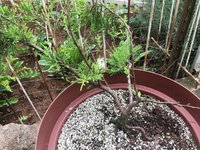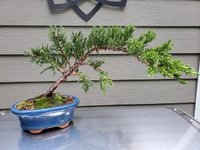I picked a rather old and gnarled Juniper Chinesis at a nursery which was in bad health at the time. I have left it alone these past few months but I have noticed that it is about to get inverse taper due to the Y shaped branches coming off the trunk. The inverse taper is not visible as it is happening on the front and back of tree as viewed from the sides. I am pretty new to Junipers and conifers and wanted some wisdom and advice in choosing which branch to remove. So far I am leaning to removing/jinning the right, thinner branch because the thicker one on the left shows better character and would result in better taper. I have attached some photos.
View attachment 420800
View attachment 420801
The tree at this point appears to have very little foliage and therefore is in no danger of creating inverse taper any time soon. Actually it appears to be a young specimen that has been overworked at this point. Does not appear to be an olden gnarled specimen, simply a close up photo of a young juniper as indicated by the plastic pot rim in the background of the photo and the size of the roots. Also the right smallest branch appears to have had all side foliage removed so Jin or removal appears to be the only option. I would advise letting it gain strength and increase the amount of foliage before continuing to work the tree.
When the tree has enough strength to move forward I would be incline to create more taper and movement by reducing to one trunk line as follows.
1. Remove the left thicker branch.
2. Remove the right side branch at the first Y movement.
This combines movement and taper with two step downs in trunk diameter and several changes of direction. It also leaves thinner portions to wire and form for further design.
Just another perspective, obviously we are viewing this situation differently.






